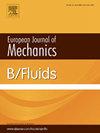A wind tunnel experimental investigation for the flow normal to a flat plate attached with a closed membrane coating
IF 2.5
3区 工程技术
Q2 MECHANICS
引用次数: 0
Abstract
Wind tunnel experiments were conducted to study the flow normal to a flat plate attached with a closed flexible membrane. Two control parameters, the membrane width and the wind speed, were considered. A suspension device was designed to measure the aerodynamic forces exerted on the plate+membrane system. Experimental results show that, contingent on the membrane width, a significant drag reduction up to 22.2% is reported. Based on image recognition techniques, a measurement method using two high-speed cameras was developed to reconstruct the membrane’s motion. The time-averaged shape of the membrane is maintained as a plump D-shape cylinder. The membrane exhibits a rigid-body flapping motion and a bending deformation, accompanied by traveling waves along the membrane. Results of amplitude and standard deviation of the membrane motion show that the more intense flapping occurs on two sides of the membrane, while gentler flapping in the middle region. Furthermore, smoke-wire flow visualization reveals that the presence of the membrane significantly alters the flow structures in the delay in flow separation and the emergence of narrower wake structures, thus reducing drag. Our study demonstrates that such a flow control device using a flexible membrane coating is effective under 3D, high and turbulent flow conditions, which providing powerful evidence of its potential for practical engineering applications.
求助全文
约1分钟内获得全文
求助全文
来源期刊
CiteScore
5.90
自引率
3.80%
发文量
127
审稿时长
58 days
期刊介绍:
The European Journal of Mechanics - B/Fluids publishes papers in all fields of fluid mechanics. Although investigations in well-established areas are within the scope of the journal, recent developments and innovative ideas are particularly welcome. Theoretical, computational and experimental papers are equally welcome. Mathematical methods, be they deterministic or stochastic, analytical or numerical, will be accepted provided they serve to clarify some identifiable problems in fluid mechanics, and provided the significance of results is explained. Similarly, experimental papers must add physical insight in to the understanding of fluid mechanics.

 求助内容:
求助内容: 应助结果提醒方式:
应助结果提醒方式:


